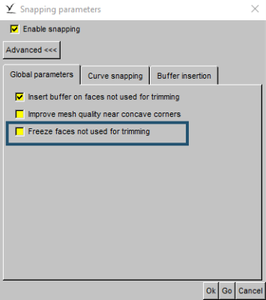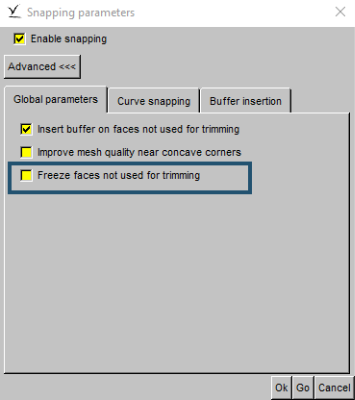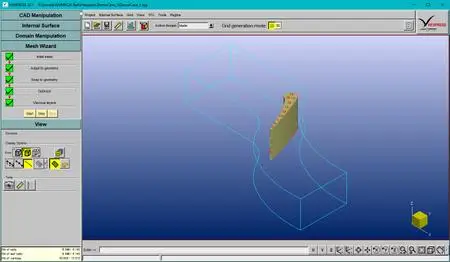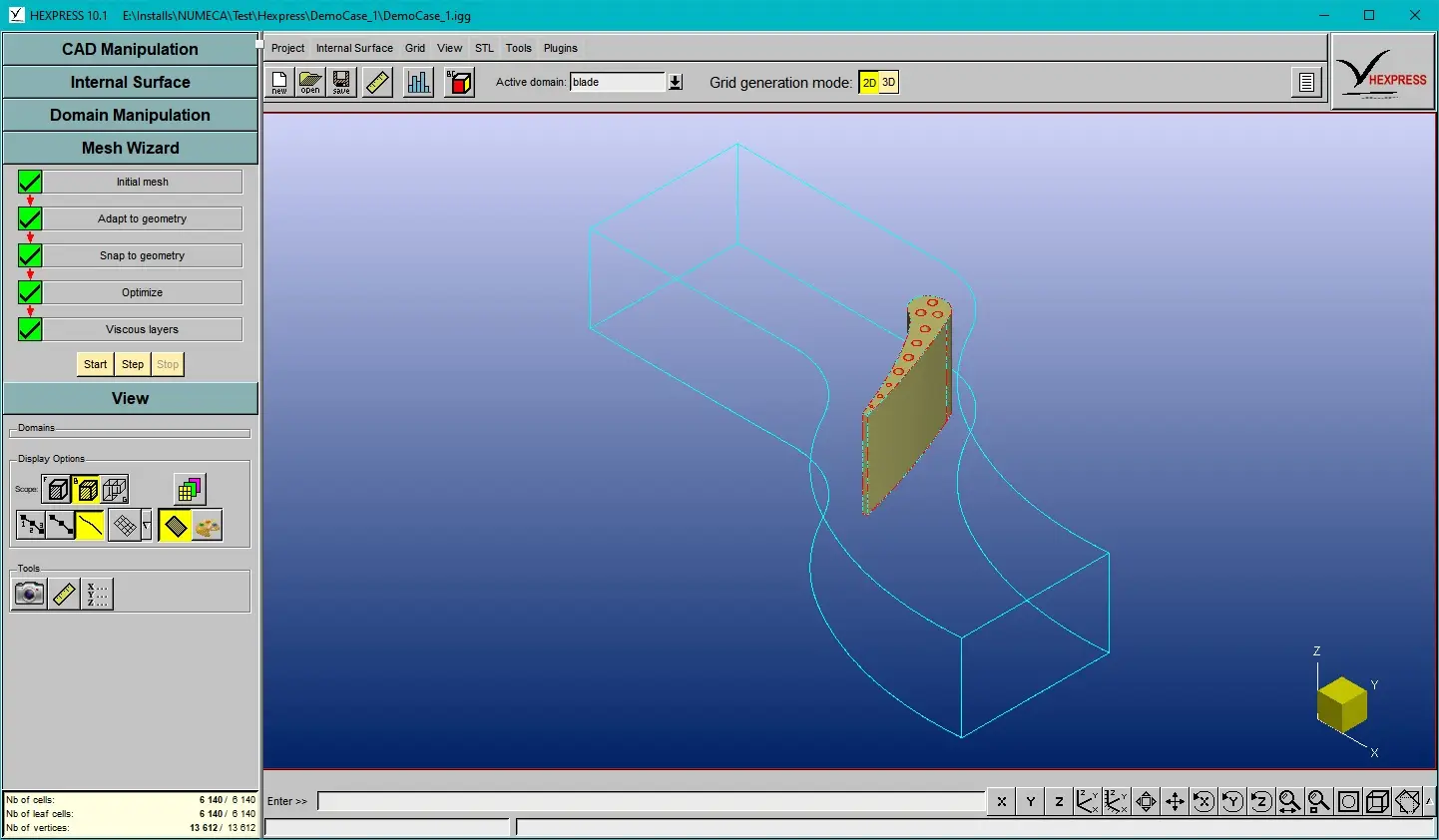NUMECA HEXPRESS / Hybrid 10.1 | 3.0 Gb
NUMECA International is delighted to announce the official release of HEXPRESS and HEXPRESS/Hybrid version 10.1. This solutions use a similar volume-to-surface approach, suppressing the need for a surface mesh. Both systems run in batch or interactive mode and are interfaced to all major commercial CFD codes.
General upgrades in the package
General package upgrades in v10.1:
- FlexLM based license security ID is upgraded to v20;
- Use of Parasolid v32.0.214;
Freeze faces not used for trimming
A cylinder is composed of two flat surfaces, that could be defined as "not used for trimming". But because of the connected and rounded surface of the cylinder, a buffer must still be inserted and propagated on the flat surfaces, leading to the activation of the smoothing as well. To overcome this particular situation that degrades the mesh quality, the new option Freeze faces not used for trimming allows to disable the smoothing on the flat surfaces to freeze them and so to improve the quality.
Improved python commands
The following python commands have been improved to return the status: 1 - success and 0 - fail. In case of failing, all processed parts will be reverted.
- scale_parts()
- rotate_parts()
- translate_parts()
Improved robustness
Several bug corrections have been done to improve:
- the robustness of the rotor-stator calculation.
- trimming condition detection.
- CATIA v6 CAD manipulation.
General package upgrades in v10.1:
- FlexLM based license security ID is upgraded to v20;
- Use of Parasolid v32.0.214;
Freeze faces not used for trimming
A cylinder is composed of two flat surfaces, that could be defined as "not used for trimming". But because of the connected and rounded surface of the cylinder, a buffer must still be inserted and propagated on the flat surfaces, leading to the activation of the smoothing as well. To overcome this particular situation that degrades the mesh quality, the new option Freeze faces not used for trimming allows to disable the smoothing on the flat surfaces to freeze them and so to improve the quality.
Improved python commands
The following python commands have been improved to return the status: 1 - success and 0 - fail. In case of failing, all processed parts will be reverted.
- scale_parts()
- rotate_parts()
- translate_parts()
Improved robustness
Several bug corrections have been done to improve:
- the robustness of the rotor-stator calculation.
- trimming condition detection.
- CATIA v6 CAD manipulation.
General upgrades in package
General package upgrades in v10.1:
- FlexLM based license security ID is upgraded to v20;
- Use of Parasolid v32.0.214.
Improved speed and robustness for distributed parallel meshing
The speed and robustness are further improved for distributed parallel meshing.
Customer Benefits
- 1.5X speed-up for mesh generations with both OpenMPI and IntelMPI.
Significant speed-up of mesh generation
The improvements done for the different functionalities below significantly speed up the mesh generation time:
- S2V full tetrahedral mesh generation;
- Viscous layers insertion with the extrusion method;
- the EXACTMESHING keyword.
Customer Benefits
2X to 10X speed-up for the mesh generation with the extrusion viscous layers method, 2X speed-up for S2V full tetrahedral meshing and 1.5X for the mesh generation with the EXACTMESHING keyword.
New OpenFOAM optimizer
A more OpenFOAM dedicated optimizer (OPTIPARAMETER 3.3) is introduced to improve the mesh quality for OpenFOAM meshes. This optimizer improves the skewness, non-orthogonality, and adjacent volume ratio, excluding the optimization for NUMECA quality (OPTIPARAMETER 0). It also performs special optimizations for sharp convex and concave configurations in the viscous layers and additionally splits cells that may produce the OpenFOAM "face pyramid error".
Customer Benefits
- Generates better mesh quality for OpenFOAM simulations.
Known Limitations
- Improvement may not be satisfying for the following configurations:
. very small first cell size of the viscous layers.
. viscous layers near sharp convex and concave dihedral angles (<90 or >270 degrees).
. meshes containing CYLINDRICALMESH, TRANSFORMSELECTIONS and Mesh Transformations keywords.
- The cell splitting technique to avoid the OpenFOAM "face pyramid error" is not performed for full hexahedral meshes with hanging nodes and mixed element meshes inside or close to the buffer type II configurations.
Improved OpenFOAM and CGNS exports
- OpenFOAM
The OpenFOAM meshes are now exported according to the OpenFOAM file structure. The mesh is saved in a folder named Constant/polyMesh located in the same directory as the *.foam file. The folder contains the following files: points, owner, neighbor, faces, and boundary.
- CGNS
The group information is now included in the CGNS mesh export.
Customer Benefits
- Having mesh exports that preserve groups and folders hierarchy.
General package upgrades in v10.1:
- FlexLM based license security ID is upgraded to v20;
- Use of Parasolid v32.0.214.
Improved speed and robustness for distributed parallel meshing
The speed and robustness are further improved for distributed parallel meshing.
Customer Benefits
- 1.5X speed-up for mesh generations with both OpenMPI and IntelMPI.
Significant speed-up of mesh generation
The improvements done for the different functionalities below significantly speed up the mesh generation time:
- S2V full tetrahedral mesh generation;
- Viscous layers insertion with the extrusion method;
- the EXACTMESHING keyword.
Customer Benefits
2X to 10X speed-up for the mesh generation with the extrusion viscous layers method, 2X speed-up for S2V full tetrahedral meshing and 1.5X for the mesh generation with the EXACTMESHING keyword.
New OpenFOAM optimizer
A more OpenFOAM dedicated optimizer (OPTIPARAMETER 3.3) is introduced to improve the mesh quality for OpenFOAM meshes. This optimizer improves the skewness, non-orthogonality, and adjacent volume ratio, excluding the optimization for NUMECA quality (OPTIPARAMETER 0). It also performs special optimizations for sharp convex and concave configurations in the viscous layers and additionally splits cells that may produce the OpenFOAM "face pyramid error".
Customer Benefits
- Generates better mesh quality for OpenFOAM simulations.
Known Limitations
- Improvement may not be satisfying for the following configurations:
. very small first cell size of the viscous layers.
. viscous layers near sharp convex and concave dihedral angles (<90 or >270 degrees).
. meshes containing CYLINDRICALMESH, TRANSFORMSELECTIONS and Mesh Transformations keywords.
- The cell splitting technique to avoid the OpenFOAM "face pyramid error" is not performed for full hexahedral meshes with hanging nodes and mixed element meshes inside or close to the buffer type II configurations.
Improved OpenFOAM and CGNS exports
- OpenFOAM
The OpenFOAM meshes are now exported according to the OpenFOAM file structure. The mesh is saved in a folder named Constant/polyMesh located in the same directory as the *.foam file. The folder contains the following files: points, owner, neighbor, faces, and boundary.
- CGNS
The group information is now included in the CGNS mesh export.
Customer Benefits
- Having mesh exports that preserve groups and folders hierarchy.
BETA features
List of existing BETA capabilities
The functionality below is included in HEXPRESS/Hybrid but requiring additional calibration. The corresponding version is set to Beta. A best practice note can be found in the documentation package.
- Surface to Volume (S2V) mesh generation
- 64 bits indexing mesh export for SPH format
- Viscous layers insertion with the extrusion method
- Viscous layers insertion with the deformation method
- Support of hanging nodes for StarCCM+ export
- Zero radius rotor/stator interface
- Multiblock meshing combining HEXPRESS/Hybrid and S2V
- Holesearcher distributed parallel on LINUX
- CGNS output in Intel MPI version on LINUX
- 64 bits indexing mesh export for Exodus HDF5 format
HEXPRESS/Hybrid is a 3D mesh generation tool developed by NUMECA for meshing large and complex geometries in a fast and flexible manner. HEXPRESS/Hybrid generates isotropic and hexahedral-dominant meshes which contain also tetrahedra, pyramids and prisms. The generated meshes can be imported into FINE/Open with OpenLabs chain. HEXPRESS/Hybrid is basically a complete package comprising several tools that provides a wide variety of functionality to the users.
HEXPRESS is an automatic unstructured hexahedral mesh generator software designed to automatically generate meshes in complex 2D and 3D geometries. HEXPRESS generates non-conformal body-fitted full hexahedral unstructured meshes on complex arbitrary geometries. In addition, the advanced smoothing capability provides high-quality boundary layers insertion. HEXPRESS uses a volume-to-surface approach, suppressing the need for a surface mesh.
Computation of a full engine using FINE/Open's NLH and combustion models. Combustion chamber generated with HEXPRESS/Hybrid. Compressor and turbine generated with AutoGrid5.
Numeca International Inc develops computational fluid dynamics (CFD) software for the simulation, design, and optimization of fluid flow and heat transfer worldwide. It offers automated and customized flow integrated environments (FINE), including FINE/Turbo for the simulation of rotating and turbomachinery flows; FINE/Open for the simulation of complex internal and external applications; and FINE/Marine for marine applications.
Product: NUMECA HEXPRESS/Hybrid
Version: 10.1
Supported Architectures: x64
Website Home Page : www.numeca.com
Language: english
System Requirements: PC / Linux *
Size: 3.0 Gb
Supported platforms and operating systems Windows
NUMECA software is supported in 64 bits on x86_64 processors only (64 bits processors that are compatible with Intel 8086 set of instructions).
Formally tested on
- Windows 8.1 Professional
- Windows 10 Professional
Please also notice that the following limitations apply:
- Parasolid uses SSE2 instruction for high performance. If your platform is not supporting the SSE2 instruction, the FINE™ GUI cannot be started.
- AMD EPYC and RYZEN processors are slower on Windows 10 compare to Linux.
Hardware requirements
Next to the standard hardware (monitor, keyboard and mouse), some specific recommendations apply in the use of NUMECA software:
- a mouse with scroll wheel is strongly recommended.
- the monitor should support 24-bit color graphics and have a 1280 x 1024 pixel resolution for adequate visualization.
- an Ethernet card should be installed and properly configured.
- NUMECA Software does not support CXFS (Clustered XFS) and IBRIX disk file systems.
Specific to HEXPRESS/Hybrid
- HEXPRESS/Hybrid makes direct use of OpenGL libraries. These libraries must thus be up-to-date, properly installed and configured before HEXPRESS/Hybrid can be started.
- Tests have only been performed on NVIDIA graphical cards.
Memory and disk space requirements
The Random Access Memory (RAM) required to run NUMECA software depends upon several factors, in particular including the number of grid points inserted in the grid, the physical models selected (turbulence, adaptation,…), the introduction of non-matching boundary conditions and the selected calculation mode (mixed or double precision). Similarly, a minimum disk space is required on the hard disk to allow the storage of the project files. The size of these files largely depends upon the number of grid points generated.
HEXPRESS
- The use of minimum 1 GB RAM is strongly recommended. As a general guideline, about 0.5 to 0.7 GB RAM are required to run a one million nodes project. The suggested swap space should be equivalent to at least 3 times the RAM installed.
- As a general guideline, a minimum of 300 MB is required to store the project files (provided that the geometry is not defined by Parasolid or CATIA files) for a one million nodes project.
HEXPRESS/Hybrid
The Random Access Memory (RAM) required to run HEXPRESS™/Hybrid depends upon several factors. In particular, the complexity of geometries and the settings of the CONF file. As a general guideline, the Random Access Memory (RAM) required to run HEXPRESS™/Hybrid are:
- for mesh without viscous layers - between 500 MB and 700 MB RAM per million of cells
- for mesh with viscous layers - between 700 MB and 900 MB RAM per million of cells
The use of minimum 4 GB RAM is mandatory, but the installation of 8 GB is recommended. The suggested swap space should be equivalent to at least three times the RAM installed.
About 1 GB is required to store a two million nodes mesh in SPH format.
Graphics requirements
NVidia graphics cards are fully supported, installed together with the latest drivers. NUMECA software makes use of the advantages of the available Graphics Card. Some trouble may however come up with the default driver OPENGL since it may not be supported by the user host computer and machine display. In order to set the system compatible with a more portable driver, typically MSW driver is used under Windows instead. Note however that the proposed drivers are usually less efficient in terms of graphical speed than the default driver.
Supported platforms and operating systems Linux
NUMECA software is supported in 64 bits on x86_64 processors only (64 bits processors that are compatible with Intel 8086 set of instructions).
Formally tested on
- Fedora Core 28
- (K)Ubuntu (ab) 18.04
- CentOS © 7
a. Debian based operating systems like Ubuntu, even if LSB compliant, are not recommended as a license server as it is known to diverge occasionally from the LSB standard.
b. For HEXPRESS/Hybrid pay attention to the changed NVIDIA driver location. It is necessary to specify its location defining the environment variable LD_LIBRARY_PATH to /usr/lib/nvidia-current/.
c. CentOS 7.5 with vmware is not supported by HEXPRESS/View.
Hardware requirements
Next to the standard hardware (monitor, keyboard and mouse), some specific recommendations apply in the use of NUMECA software:
- a mouse with scroll wheel is strongly recommended.
- the monitor should support 24-bit color graphics and have a 1280 x 1024 pixel resolution for adequate visualization.
- an Ethernet card should be installed and properly configured.
Specific to HEXPRESS/Hybrid
- HEXPRESS/Hybrid makes direct use of OpenGL libraries. These libraries must thus be up-to-date, properly installed and configured before HEXPRESS/Hybrid can be started.
- Tests have only been performed on NVIDIA graphical cards.
Memory and disk space requirements
The Random Access Memory (RAM) required to run NUMECA software depends upon several factors, in particular including the number of grid points inserted in the grid, the physical models selected (turbulence, adaptation,…), the introduction of non-matching boundary conditions and the selected calculation mode (mixed or double precision). Similarly, a minimum disk space is required on the hard disk to allow the storage of the project files. The size of these files largely depends upon the number of grid points generated.
HEXPRESS
The use of minimum 1 GB RAM is strongly recommended. As a general guideline, about 0.5 to 0.7 GB RAM are required to run a one million nodes project. The suggested swap space should be equivalent to at least 3 times the RAM installed.
As a general guideline, a minimum of 300 MB is required to store the project files (provided that the geometry is not defined by Parasolid or CATIA files) for a one million nodes project.
HEXPRESS/Hybrid
The Random Access Memory (RAM) required to run HEXPRESS/Hybrid depends upon several factors. In particular, the complexity of geometries and the settings of the CONF file. As a general guideline, the Random Access Memory (RAM) required to run HEXPRESS/Hybrid are:
- for mesh without viscous layers - between 500 MB and 700 MB RAM per million of cells
- for mesh with viscous layers - between 700 MB and 900 MB RAM per million of cells
The use of minimum 4 GB RAM is mandatory, but the installation of 8 GB is recommended. The suggested swap space should be equivalent to at least three times the RAM installed. About 1 GB is required to store a two million nodes mesh in SPH format.
Graphics requirements
NVidia graphics cards are fully supported, installed together with the latest drivers. NUMECA software makes use of the advantages of the available Graphics Card. By default, the driver OPENGL is used.
NUMECA software is supported in 64 bits on x86_64 processors only (64 bits processors that are compatible with Intel 8086 set of instructions).
Formally tested on
- Windows 8.1 Professional
- Windows 10 Professional
Please also notice that the following limitations apply:
- Parasolid uses SSE2 instruction for high performance. If your platform is not supporting the SSE2 instruction, the FINE™ GUI cannot be started.
- AMD EPYC and RYZEN processors are slower on Windows 10 compare to Linux.
Hardware requirements
Next to the standard hardware (monitor, keyboard and mouse), some specific recommendations apply in the use of NUMECA software:
- a mouse with scroll wheel is strongly recommended.
- the monitor should support 24-bit color graphics and have a 1280 x 1024 pixel resolution for adequate visualization.
- an Ethernet card should be installed and properly configured.
- NUMECA Software does not support CXFS (Clustered XFS) and IBRIX disk file systems.
Specific to HEXPRESS/Hybrid
- HEXPRESS/Hybrid makes direct use of OpenGL libraries. These libraries must thus be up-to-date, properly installed and configured before HEXPRESS/Hybrid can be started.
- Tests have only been performed on NVIDIA graphical cards.
Memory and disk space requirements
The Random Access Memory (RAM) required to run NUMECA software depends upon several factors, in particular including the number of grid points inserted in the grid, the physical models selected (turbulence, adaptation,…), the introduction of non-matching boundary conditions and the selected calculation mode (mixed or double precision). Similarly, a minimum disk space is required on the hard disk to allow the storage of the project files. The size of these files largely depends upon the number of grid points generated.
HEXPRESS
- The use of minimum 1 GB RAM is strongly recommended. As a general guideline, about 0.5 to 0.7 GB RAM are required to run a one million nodes project. The suggested swap space should be equivalent to at least 3 times the RAM installed.
- As a general guideline, a minimum of 300 MB is required to store the project files (provided that the geometry is not defined by Parasolid or CATIA files) for a one million nodes project.
HEXPRESS/Hybrid
The Random Access Memory (RAM) required to run HEXPRESS™/Hybrid depends upon several factors. In particular, the complexity of geometries and the settings of the CONF file. As a general guideline, the Random Access Memory (RAM) required to run HEXPRESS™/Hybrid are:
- for mesh without viscous layers - between 500 MB and 700 MB RAM per million of cells
- for mesh with viscous layers - between 700 MB and 900 MB RAM per million of cells
The use of minimum 4 GB RAM is mandatory, but the installation of 8 GB is recommended. The suggested swap space should be equivalent to at least three times the RAM installed.
About 1 GB is required to store a two million nodes mesh in SPH format.
Graphics requirements
NVidia graphics cards are fully supported, installed together with the latest drivers. NUMECA software makes use of the advantages of the available Graphics Card. Some trouble may however come up with the default driver OPENGL since it may not be supported by the user host computer and machine display. In order to set the system compatible with a more portable driver, typically MSW driver is used under Windows instead. Note however that the proposed drivers are usually less efficient in terms of graphical speed than the default driver.
Supported platforms and operating systems Linux
NUMECA software is supported in 64 bits on x86_64 processors only (64 bits processors that are compatible with Intel 8086 set of instructions).
Formally tested on
- Fedora Core 28
- (K)Ubuntu (ab) 18.04
- CentOS © 7
a. Debian based operating systems like Ubuntu, even if LSB compliant, are not recommended as a license server as it is known to diverge occasionally from the LSB standard.
b. For HEXPRESS/Hybrid pay attention to the changed NVIDIA driver location. It is necessary to specify its location defining the environment variable LD_LIBRARY_PATH to /usr/lib/nvidia-current/.
c. CentOS 7.5 with vmware is not supported by HEXPRESS/View.
Hardware requirements
Next to the standard hardware (monitor, keyboard and mouse), some specific recommendations apply in the use of NUMECA software:
- a mouse with scroll wheel is strongly recommended.
- the monitor should support 24-bit color graphics and have a 1280 x 1024 pixel resolution for adequate visualization.
- an Ethernet card should be installed and properly configured.
Specific to HEXPRESS/Hybrid
- HEXPRESS/Hybrid makes direct use of OpenGL libraries. These libraries must thus be up-to-date, properly installed and configured before HEXPRESS/Hybrid can be started.
- Tests have only been performed on NVIDIA graphical cards.
Memory and disk space requirements
The Random Access Memory (RAM) required to run NUMECA software depends upon several factors, in particular including the number of grid points inserted in the grid, the physical models selected (turbulence, adaptation,…), the introduction of non-matching boundary conditions and the selected calculation mode (mixed or double precision). Similarly, a minimum disk space is required on the hard disk to allow the storage of the project files. The size of these files largely depends upon the number of grid points generated.
HEXPRESS
The use of minimum 1 GB RAM is strongly recommended. As a general guideline, about 0.5 to 0.7 GB RAM are required to run a one million nodes project. The suggested swap space should be equivalent to at least 3 times the RAM installed.
As a general guideline, a minimum of 300 MB is required to store the project files (provided that the geometry is not defined by Parasolid or CATIA files) for a one million nodes project.
HEXPRESS/Hybrid
The Random Access Memory (RAM) required to run HEXPRESS/Hybrid depends upon several factors. In particular, the complexity of geometries and the settings of the CONF file. As a general guideline, the Random Access Memory (RAM) required to run HEXPRESS/Hybrid are:
- for mesh without viscous layers - between 500 MB and 700 MB RAM per million of cells
- for mesh with viscous layers - between 700 MB and 900 MB RAM per million of cells
The use of minimum 4 GB RAM is mandatory, but the installation of 8 GB is recommended. The suggested swap space should be equivalent to at least three times the RAM installed. About 1 GB is required to store a two million nodes mesh in SPH format.
Graphics requirements
NVidia graphics cards are fully supported, installed together with the latest drivers. NUMECA software makes use of the advantages of the available Graphics Card. By default, the driver OPENGL is used.
Please visit my blog
Added by 3% of the overall size of the archive of information for the restoration
No mirrors please
Added by 3% of the overall size of the archive of information for the restoration
No mirrors please









